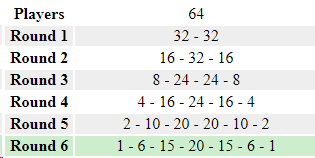A. Tournaments need a winner.
They don't need prizes, or long term ramifications, but this is their main function; it is their nature.
B. The winner of the tournament should be decided by a match of Magic: the Gathering.
Winners determined by tiebreakers is a far less compelling experience for everyone involved.
C. The participants of that tournament deciding match should know the stakes as the game is being played.
It can be argued that winning your last match to move into a tie with the leader and then winning the event on tiebreakers still satisfies point B, so this point shows how that fails to create the drama of a winner-take-all match.
At this point, there are three main ways I've identified which meet those requirements. Those are:
1. Elimination Bracket tournament
2. Some preliminary rounds (can vary in structure and number) followed by a Elimination Cut
3. Straight Swiss
Elimination Brackets - straightforward for single elimination, increasingly complicated for double or triple or higher. Hard to have simultaneous play for double or more, lots of player downtime waiting for results. Single elimination does not provide enough matches of Magic for the average player. Generally Single Elimination is worse than Straight Swiss
Straight Swiss - this is effectively Single Elimination and, in fact, it can be run as such if you are willing to end the tournament once there is only one undefeated player left. Only when using a fixed number of rounds can you run into trouble where the winner is determined by tiebreakers. This happens when a paired-down player in the penultimate round loses, leaving only one undefeated player left for the final round. Then, this player also loses, creating a two- or three- or more way tie for first. As you approach the power-of-two limit for number of players, this situation happens less often.
Swiss plus one - I don't know why this is popular. This was a weird structure invented to distribute prizes at GP side events in the late 2000s and it terrible at actually identifying a winner. If a player goes undefeated, it is no different than Swiss, but it guarantees the pair-down situation that causes straight Swiss to fail.
Elimination Cut - Top 8 is the standard, but there are other options. Top 16, Top 6 with byes, top 12 with byes, etc. Preliminary rounds can also vary with Swiss, group play, or Round Robin all possible depending on number of players. Deciding where to draw the line is key.
Personal Opinion - Elimination Cut playoffs are the best for both players and spectators. I suppose it is worse for the TOs, and they are the ones making the call. I find it humorous that European Old School events all use Elimination Cut playoffs and American ones do not, when it is the exact opposite divide in the soccer/football leagues. Playoffs are American; lets do them more!
D. Tiebreakers may be inevitable, but the impact of them should be minimized.
A good reason for cut to elimination rounds is the tiebreaker is now between the 8th and 9th place person instead of the 1st and 2nd. This can be further improved in situations with byes in the elimination rounds, where there are two different possible tiebreaker impacts, and each is a smaller overall impact.
E. Intentional Drawing is not immoral.
Draws may be discussed in the future, but for this post it is assumed draws and intentional draws are possible and allowed.
F. Intentional Drawing is largely a waste of time.
Many times in swiss plus top 8, the top 8 is locked going into the final round if they all agree to intentional draw. This effectively means the last round of the swiss is devoid of drama, which does not make sense for a final round.
G. Starting the playoffs a round earlier gives you more time to finish the playoffs and may be more palatable to the TO.
Having the first round of top 8 during prize announcements for other prizes could work to save time.
H. Therefore, Swiss Minus One
This creates the same top 8 as normal Swiss a lot of the time, especially at lower ends of the player count range. Swiss round recommendations are designed so that everyone at X-1 or better is guaranteed to make top 8. I don't see a strong argument for why this needs to be the case in the OS community. The tiebreaks will still be between 8th and 9th as normal swiss.
Glorycon Specific notes:
64 Players
Note after round 5, you would expect two of the 4-1s to ID and the other 8 to play for the final four spots. This is because you have the maximum number of people for the recommended round count. A cut after round 5 would still have the same people in contention, but instead be decided on tiebreakers.
74 Players
80 Players
Just an illustration that while 7 rounds is recommended, in this case 6 rounds would only have one 5-1 player miss the top 8 on breakers.


